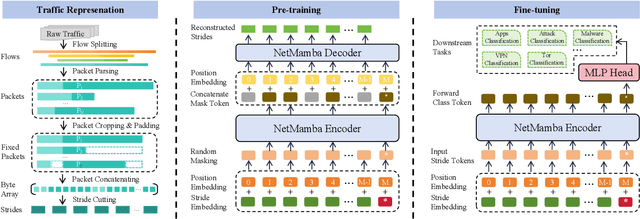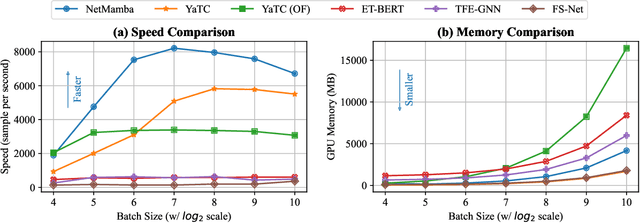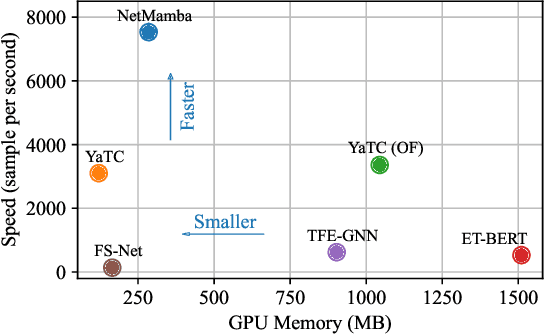Yong Cui
KeepKV: Eliminating Output Perturbation in KV Cache Compression for Efficient LLMs Inference
Apr 14, 2025Abstract:Efficient inference of large language models (LLMs) is hindered by an ever-growing key-value (KV) cache, making KV cache compression a critical research direction. Traditional methods selectively evict less important KV cache entries based on attention scores or position heuristics, which leads to information loss and hallucinations. Recently, merging-based strategies have been explored to retain more information by merging KV pairs that would be discarded; however, these existing approaches inevitably introduce inconsistencies in attention distributions before and after merging, causing output perturbation and degraded generation quality. To overcome this challenge, we propose KeepKV, a novel adaptive KV cache merging method designed to eliminate output perturbation while preserving performance under strict memory constraints. KeepKV introduces the Electoral Votes mechanism that records merging history and adaptively adjusts attention scores. Moreover, it further leverages a novel Zero Inference-Perturbation Merging methods, keeping attention consistency and compensating for attention loss resulting from cache merging. KeepKV successfully retains essential context information within a significantly compressed cache. Extensive experiments on various benchmarks and LLM architectures demonstrate that KeepKV substantially reduces memory usage, enhances inference throughput by more than 2x and keeps superior generation quality even with 10% KV cache budgets.
Robust Deep Reinforcement Learning in Robotics via Adaptive Gradient-Masked Adversarial Attacks
Mar 26, 2025Abstract:Deep reinforcement learning (DRL) has emerged as a promising approach for robotic control, but its realworld deployment remains challenging due to its vulnerability to environmental perturbations. Existing white-box adversarial attack methods, adapted from supervised learning, fail to effectively target DRL agents as they overlook temporal dynamics and indiscriminately perturb all state dimensions, limiting their impact on long-term rewards. To address these challenges, we propose the Adaptive Gradient-Masked Reinforcement (AGMR) Attack, a white-box attack method that combines DRL with a gradient-based soft masking mechanism to dynamically identify critical state dimensions and optimize adversarial policies. AGMR selectively allocates perturbations to the most impactful state features and incorporates a dynamic adjustment mechanism to balance exploration and exploitation during training. Extensive experiments demonstrate that AGMR outperforms state-of-the-art adversarial attack methods in degrading the performance of the victim agent and enhances the victim agent's robustness through adversarial defense mechanisms.
State-Aware Perturbation Optimization for Robust Deep Reinforcement Learning
Mar 26, 2025Abstract:Recently, deep reinforcement learning (DRL) has emerged as a promising approach for robotic control. However, the deployment of DRL in real-world robots is hindered by its sensitivity to environmental perturbations. While existing whitebox adversarial attacks rely on local gradient information and apply uniform perturbations across all states to evaluate DRL robustness, they fail to account for temporal dynamics and state-specific vulnerabilities. To combat the above challenge, we first conduct a theoretical analysis of white-box attacks in DRL by establishing the adversarial victim-dynamics Markov decision process (AVD-MDP), to derive the necessary and sufficient conditions for a successful attack. Based on this, we propose a selective state-aware reinforcement adversarial attack method, named STAR, to optimize perturbation stealthiness and state visitation dispersion. STAR first employs a soft mask-based state-targeting mechanism to minimize redundant perturbations, enhancing stealthiness and attack effectiveness. Then, it incorporates an information-theoretic optimization objective to maximize mutual information between perturbations, environmental states, and victim actions, ensuring a dispersed state-visitation distribution that steers the victim agent into vulnerable states for maximum return reduction. Extensive experiments demonstrate that STAR outperforms state-of-the-art benchmarks.
LLM-Sketch: Enhancing Network Sketches with LLM
Feb 11, 2025Abstract:Network stream mining is fundamental to many network operations. Sketches, as compact data structures that offer low memory overhead with bounded accuracy, have emerged as a promising solution for network stream mining. Recent studies attempt to optimize sketches using machine learning; however, these approaches face the challenges of lacking adaptivity to dynamic networks and incurring high training costs. In this paper, we propose LLM-Sketch, based on the insight that fields beyond the flow IDs in packet headers can also help infer flow sizes. By using a two-tier data structure and separately recording large and small flows, LLM-Sketch improves accuracy while minimizing memory usage. Furthermore, it leverages fine-tuned large language models (LLMs) to reliably estimate flow sizes. We evaluate LLM-Sketch on three representative tasks, and the results demonstrate that LLM-Sketch outperforms state-of-the-art methods by achieving a $7.5\times$ accuracy improvement.
Leveraging LLM Agents for Translating Network Configurations
Jan 15, 2025Abstract:Configuration translation is a critical and frequent task in network operations. When a network device is damaged or outdated, administrators need to replace it to maintain service continuity. The replacement devices may originate from different vendors, necessitating configuration translation to ensure seamless network operation. However, translating configurations manually is a labor-intensive and error-prone process. In this paper, we propose an intent-based framework for translating network configuration with Large Language Model (LLM) Agents. The core of our approach is an Intent-based Retrieval Augmented Generation (IRAG) module that systematically splits a configuration file into fragments, extracts intents, and generates accurate translations. We also design a two-stage verification method to validate the syntax and semantics correctness of the translated configurations. We implement and evaluate the proposed method on real-world network configurations. Experimental results show that our method achieves 97.74% syntax correctness, outperforming state-of-the-art methods in translation accuracy.
Rethinking Adversarial Attacks in Reinforcement Learning from Policy Distribution Perspective
Jan 08, 2025Abstract:Deep Reinforcement Learning (DRL) suffers from uncertainties and inaccuracies in the observation signal in realworld applications. Adversarial attack is an effective method for evaluating the robustness of DRL agents. However, existing attack methods targeting individual sampled actions have limited impacts on the overall policy distribution, particularly in continuous action spaces. To address these limitations, we propose the Distribution-Aware Projected Gradient Descent attack (DAPGD). DAPGD uses distribution similarity as the gradient perturbation input to attack the policy network, which leverages the entire policy distribution rather than relying on individual samples. We utilize the Bhattacharyya distance in DAPGD to measure policy similarity, enabling sensitive detection of subtle but critical differences between probability distributions. Our experiment results demonstrate that DAPGD achieves SOTA results compared to the baselines in three robot navigation tasks, achieving an average 22.03% higher reward drop compared to the best baseline.
Fast Inference for Augmented Large Language Models
Oct 25, 2024



Abstract:Augmented Large Language Models (LLMs) enhance the capabilities of standalone LLMs by integrating external data sources through API calls. In interactive LLM applications, efficient scheduling is crucial for maintaining low request completion times, directly impacting user engagement. However, these augmentations introduce scheduling challenges due to the need to manage limited memory for cached information (KV caches). As a result, traditional size-based scheduling algorithms, such as Shortest Job First (SJF), become less effective at minimizing completion times. Existing work focuses only on handling requests during API calls by preserving, discarding, or swapping memory without considering how to schedule requests with API calls. In this paper, we propose LAMPS, a novel LLM inference framework for augmented LLMs. LAMPS minimizes request completion time through a unified scheduling approach that considers the total length of requests and their handling strategies during API calls. Recognizing that LLM inference is memory-bound, our approach ranks requests based on their consumption of memory over time, which depends on both the output sizes and how a request is managed during its API calls. To implement our scheduling, LAMPS predicts the strategy that minimizes memory waste of a request during its API calls, aligning with but improving upon existing approaches. We also propose starvation prevention techniques and optimizations to mitigate the overhead of our scheduling. We implement LAMPS on top of vLLM and evaluate its performance against baseline LLM inference systems, demonstrating improvements in end-to-end latency by 27%-85% and reductions in TTFT by 4%-96% compared to the existing augmented-LLM system, with even greater gains over vLLM.
Efficient Inference for Augmented Large Language Models
Oct 23, 2024



Abstract:Augmented Large Language Models (LLMs) enhance the capabilities of standalone LLMs by integrating external data sources through API calls. In interactive LLM applications, efficient scheduling is crucial for maintaining low request completion times, directly impacting user engagement. However, these augmentations introduce scheduling challenges due to the need to manage limited memory for cached information (KV caches). As a result, traditional size-based scheduling algorithms, such as Shortest Job First (SJF), become less effective at minimizing completion times. Existing work focuses only on handling requests during API calls by preserving, discarding, or swapping memory without considering how to schedule requests with API calls. In this paper, we propose LAMPS, a novel LLM inference framework for augmented LLMs. LAMPS minimizes request completion time through a unified scheduling approach that considers the total length of requests and their handling strategies during API calls. Recognizing that LLM inference is memory-bound, our approach ranks requests based on their consumption of memory over time, which depends on both the output sizes and how a request is managed during its API calls. To implement our scheduling, LAMPS predicts the strategy that minimizes memory waste of a request during its API calls, aligning with but improving upon existing approaches. We also propose starvation prevention techniques and optimizations to mitigate the overhead of our scheduling. We implement LAMPS on top of vLLM and evaluate its performance against baseline LLM inference systems, demonstrating improvements in end-to-end latency by 27%-85% and reductions in TTFT by 4%-96% compared to the existing augmented-LLM system, with even greater gains over vLLM.
NetMamba: Efficient Network Traffic Classification via Pre-training Unidirectional Mamba
May 19, 2024



Abstract:Network traffic classification is a crucial research area aiming to enhance service quality, streamline network management, and bolster cybersecurity. To address the growing complexity of transmission encryption techniques, various machine learning and deep learning methods have been proposed. However, existing approaches encounter two main challenges. Firstly, they struggle with model inefficiency due to the quadratic complexity of the widely used Transformer architecture. Secondly, they suffer from unreliable traffic representation because of discarding important byte information while retaining unwanted biases. To address these challenges, we propose NetMamba, an efficient linear-time state space model equipped with a comprehensive traffic representation scheme. We replace the Transformer with our specially selected and improved Mamba architecture for the networking field to address efficiency issues. In addition, we design a scheme for traffic representation, which is used to extract valid information from massive traffic while removing biased information. Evaluation experiments on six public datasets encompassing three main classification tasks showcase NetMamba's superior classification performance compared to state-of-the-art baselines. It achieves up to 4.83\% higher accuracy and 4.64\% higher f1 score on encrypted traffic classification tasks. Additionally, NetMamba demonstrates excellent efficiency, improving inference speed by 2.24 times while maintaining comparably low memory usage. Furthermore, NetMamba exhibits superior few-shot learning abilities, achieving better classification performance with fewer labeled data. To the best of our knowledge, NetMamba is the first model to tailor the Mamba architecture for networking.
DoLLM: How Large Language Models Understanding Network Flow Data to Detect Carpet Bombing DDoS
May 13, 2024



Abstract:It is an interesting question Can and How Large Language Models (LLMs) understand non-language network data, and help us detect unknown malicious flows. This paper takes Carpet Bombing as a case study and shows how to exploit LLMs' powerful capability in the networking area. Carpet Bombing is a new DDoS attack that has dramatically increased in recent years, significantly threatening network infrastructures. It targets multiple victim IPs within subnets, causing congestion on access links and disrupting network services for a vast number of users. Characterized by low-rates, multi-vectors, these attacks challenge traditional DDoS defenses. We propose DoLLM, a DDoS detection model utilizes open-source LLMs as backbone. By reorganizing non-contextual network flows into Flow-Sequences and projecting them into LLMs semantic space as token embeddings, DoLLM leverages LLMs' contextual understanding to extract flow representations in overall network context. The representations are used to improve the DDoS detection performance. We evaluate DoLLM with public datasets CIC-DDoS2019 and real NetFlow trace from Top-3 countrywide ISP. The tests have proven that DoLLM possesses strong detection capabilities. Its F1 score increased by up to 33.3% in zero-shot scenarios and by at least 20.6% in real ISP traces.
 Add to Chrome
Add to Chrome Add to Firefox
Add to Firefox Add to Edge
Add to Edge